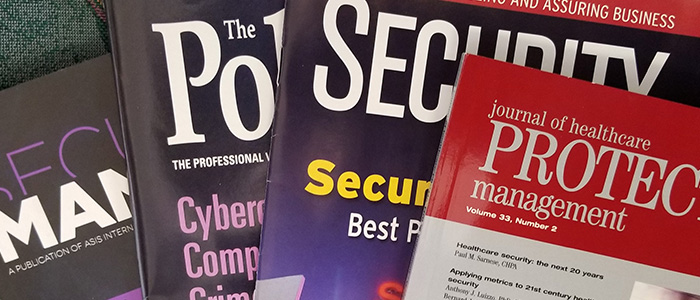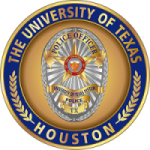Safety and Threat Publications

Navigating having a blended sworn and non-sworn security operation
Drew Dasher, PhD, MBA, CPP; Olivia Manzano-Limas, BS; and Claudia Garcia, BA
A few concrete steps can help to minimize the conflicts that arise as a result of differences between the two groups.
Crime Analysis Techniques for Healthcare Security
Andrew Dasher, PhD, MBA, CPP, and Samantha Russo, MS
Today’s security professional is expected to be a Swiss Army knife type person. One set of skills that is often overlooked, in the private sector at least, pertains to crime analysis. This field of study has developed several principles and practices that have application not only to law enforcement but also to the non-police security world.
The Many Benefits of Strategic Mapping
Ray Gerwitz, MBA, CHPA, CPP; Robert Haynes, MPA, APP, and Jason Lipe, MBA, PMP
Relying on their contributions to developing UT Police’s yearly strategic map and strategic plan, first introduced in 2017, the authors provide a series of steps that can help other organizations create a strategy map that provides value to both the organization and its employees.
For a copy of the article published in the Journal of Healthcare Protection Management, please contact Robert Haynes at [email protected].
‘Take the Shot, Save a Life’ Program Addresses Vaccine Hesitancy in Students
Dr. Charles Denham II, William Adcox, Charles Denham III, and Dr. Gregory Botz, 09/03/2021
This new program enables youth and young adults to educate their peers on the safety and necessity of COVID-19 vaccines, as well as encourage them to “take the shot.”
COVID-19 Safety Plans: How Protecting Your Family Can Help Save America
Chief William Adcox, Dr. Gregory Botz, Dr. Charles Denham II, Charles Denham II, 03/02/2021
If you break the family- and living-unitCOVID-19transmission chains, you can save the lives of teachers, healthcare workers and police officers. You might even help save our nation.
Survive and Thrive Guide
Charles Denham, II, MD, William Adcox, Charles Denham III, Jaime Yrastorza, and Gregory Botz, MD, FCCM, 01/04/2021
This article is a narrative summary of the short film entitled Masks: The SCIENCE of Success posted on the Med Tac Global website providing access to free films and resources to families of the Essential Critical Infrastructure Workers of sixteen industry sectors and the general public.
Three Novel Ways to Use ALPR
Andrew Dasher, PhD, Threat and Risk Analyst, University of Texas Police at Houston, 03/18/2020
Automated license plate readers (ALPR) are being utilized across the world in a variety of ways and for myriad purposes. Law enforcement has primarily used these devices as a way to facilitate traffic enforcement, such as looking for expired plates, or to help identify vehicles where the vehicle itself is associated with the crime, such as an auto theft, or to find a wanted person.
Using Business Tools to Enhance Your Team's Success
Ray Gerwitz, MBA, CHPA, CPP, Executive Director and Deputy Chief Security Officer, UT Police at Houston, 03/01/2020
Security leaders would do themselves a favor by adapting a few business tools for strategic planning and assessment of success. In particular, three visualization tools—strategic mapping, storyboarding, and data visualization—can help to optimize performance, control costs, enhance team members’ enthusiasm, and increase upper management’s trust in the department.
Emerging Threats in Healthcare and the Adaptation of Protection Models
Raymond J. Gerwitz, UT Police at Houston, 03/13/2018
The challenges faced by today’s healthcare security executives emerge at a much faster cadence than in years past. This reality has over time has migrated the healthcare security executive’s role from a traditional crime-focused leader of “gates, guards, and guns” to a business leader committed to Prevention, Preparedness and Protection. Success in this transitioned role is defined by outcomes resulting in a reduction of harm to patients and visitors, the organization, and the technology systems that support them.
Moving Police Officers From Enforcers to Protectors
Everette B. Penn, Ph.D., University of Houston-Clear Lake, and Vicki L. King, UT Police at Houston, 01/02/2017
The chant “I hate the police” emerges as a common anthem among today’s minority and urban youth. Bridging this widening divide requires police to reconsider the negative impact of zero tolerance, stop-and-frisk, and saturation patrol tactics which cast a wide net, often catching “dolphins with the tuna.” Education and awareness programs, like the Teen and Police Service Academy (TAPS), offer opportunities for enhanced understanding and awareness for both teens and police. As legislators consider mandating this type of training for Texas children, police must evolve from a warrior identity toward that of a protector.
Modern strategy for operational excellence: building agile and adaptive organizations
Raymond J. Gerwitz, UT Police at Houston, 01/01/2017
Healthcare security leaders who serve in an industry built on traditional and static protection and response protocols must become more agile and adaptive in planning and responding to evolving threat and risk profiles, the author states. In this article, he tells how to use operational excellence to continuously improve performance.
Overcoming Law Enforcement Data Obstacles
Andrew Dasher, Ph.D., UT Police at Houston, and Robert Haynes, MPA, UT Police at Houston, 01/01/2017
Law enforcement departments are becoming more reliant on technology that use digital data to complete workflows and share information. The trend towards overall efficiency, rather than sheer manpower, has fueled the proliferation of hardware nationwide.
